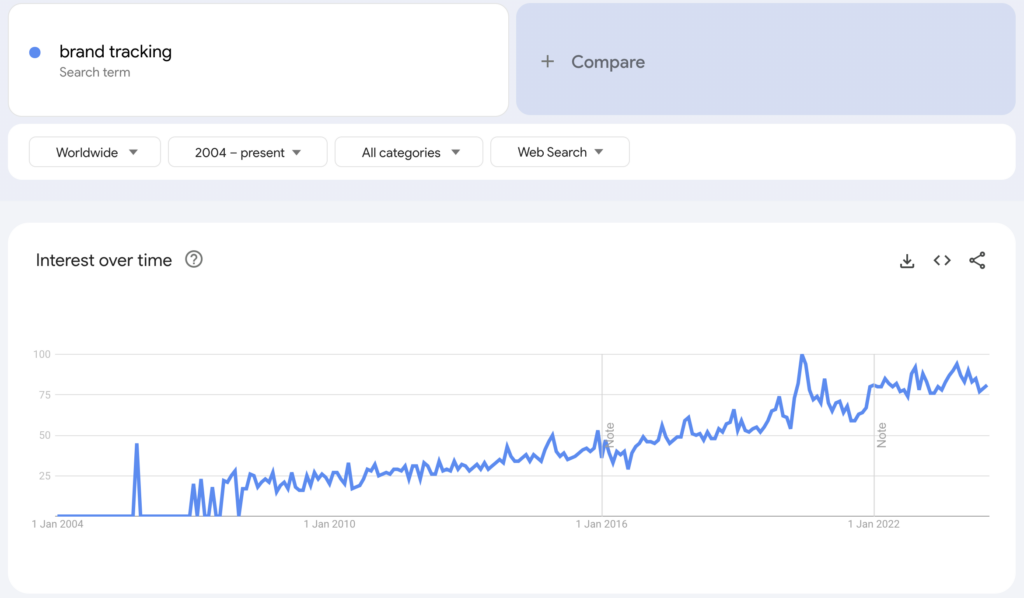
Brand managers are divided when it comes to brand tracking. Some see it as a vital management tool that they can’t live without. Many others, for very valid reasons, do not know what to do with the data and see their brand tracker as a waste of resources. Why is this happening? And what should you do about it?
Is brand tracking broken?
A quick search on the internet could lead anyone to believe that brand trackers are on the brink of extinction, like the dinosaurs. The list of pitfalls associated with traditional brand trackers is long, and I would not be surprised if many brand managers agree with at least some of them:
- They are too slow. By the time the data is delivered, it is already old, making it difficult to make decisions based on it. Like driving by looking in the rear-view mirror.
- Frequency is not enough. Annual or quarterly data sets are not useful for spotting emerging trends and taking timely corrective action.
- Data is static. Sometimes data does not change over time, leaving brand managers trying to figure out what to do with a bunch of flat lines.
- Questionnaires are difficult to evolve. Because the questions were defined in a precise way a long time ago, any change to the questionnaire will break historical trends. Nobody dares to do that.
- They are too complex or too simple. Either they include questions that no longer seem relevant, or they fail to include data that is essential to understanding the full picture.
- They do not always correlate with sales. Brand tracker data and actual sales figures can move in opposite directions. This scenario can create tension with departments and CEOs who are more focused on short-term performance.
- Results are not used. Because of some of the previous points, or simply because the figures do not show what the brand manager wants to tell the management team, results are very often unused.
- They are expensive. Why pay for research when you can get tons of data on brands for free these days?
Looking at this list, I can understand why some brand managers and CMOs admit to struggling with their brand tracking. I also recognise that they may not have been involved in defining the brand tracker. As brand trackers are a long-term tool, they may have been set up by their predecessors. They may have had their own ideas about how to manage the brand, or they may have worked in a different context and had different needs. Talking to brand managers, it is not uncommon to find that the rationale for why the tracker was defined in the way it was has been lost.
Nobody said that brand trackers would be easy to manage, but let’s not throw them out just yet…
Interest in brand trackers at an all-time high
Despite all the real and imagined pitfalls – and we’ll talk about them later – brand tracking is experiencing a revival. Most of the articles on the internet proclaiming the «death of brand tracking» are advocating a new way of doing it, one that solves some of its pitfalls once and for all. Some others promote an alternative to brand trackers to help brand managers understand how to improve their brand contribution.
So brand tracking is not dead. In fact, if we take a look at Google Trends, we can see that the volume of searches about brand tracking has never been higher.

Long-term brand building is back
Part of the reason for this renewed interest is that long-term brand-building strategies themselves have become more important in recent years.
Brand managers and CFOs are now more aware of the fact that performance advertising creates a short-term spike in sales that drops off when the campaign ends. However, good brand-building advertising has a long-term impact on sales and makes future campaigns more successful. The high-profile case of AirBnB has provided real-world evidence to support a renewed interest in long-term brand building.
But if brand building is a long-term game, how can brand managers measure the impact of their actions on brand health? Most marketing performance measurement systems are designed to provide insight into what people do in the short term. But they are less effective at measuring long-term marketing impact, and have been heavily criticised for this. In addition, tools such as attribution models focus on what people do, but do not give any indication of what happens in people’s minds. Is the brand being forgotten? Is it as relevant as it used to be? How does it compare to its competitors?
All of this information is vital to the growth of any brand. And yes, even today, asking people is the only way to understand what is going on in their minds.
The question is, how can brand managers define the right strategies to improve their brand health without a proper long-term brand measurement tool? Personally, I don’t think it’s possible…
Brand managers at a crossroads
Brand trackers are very much alive and more relevant than ever. At the same time, trackers smell funny in many companies. They were defined long ago and have become obsolete over time. Brand managers need to be bold and move «fixing brand tracking» from the back burner to the top of the priority list. The right brand tracker will help any brand manager identify opportunities and make the right decisions to build brand strength. And it can be a game changer in conversations with the CEO and CFO to unlock the resources needed to grow the brand for the long term.
At Origin Insights, we can help you evolve your brand tracker into the tool it should always be. In the next post on this topic, I will tell you more about how this can be done successfully. Watch this space…
Do you want to know more?


